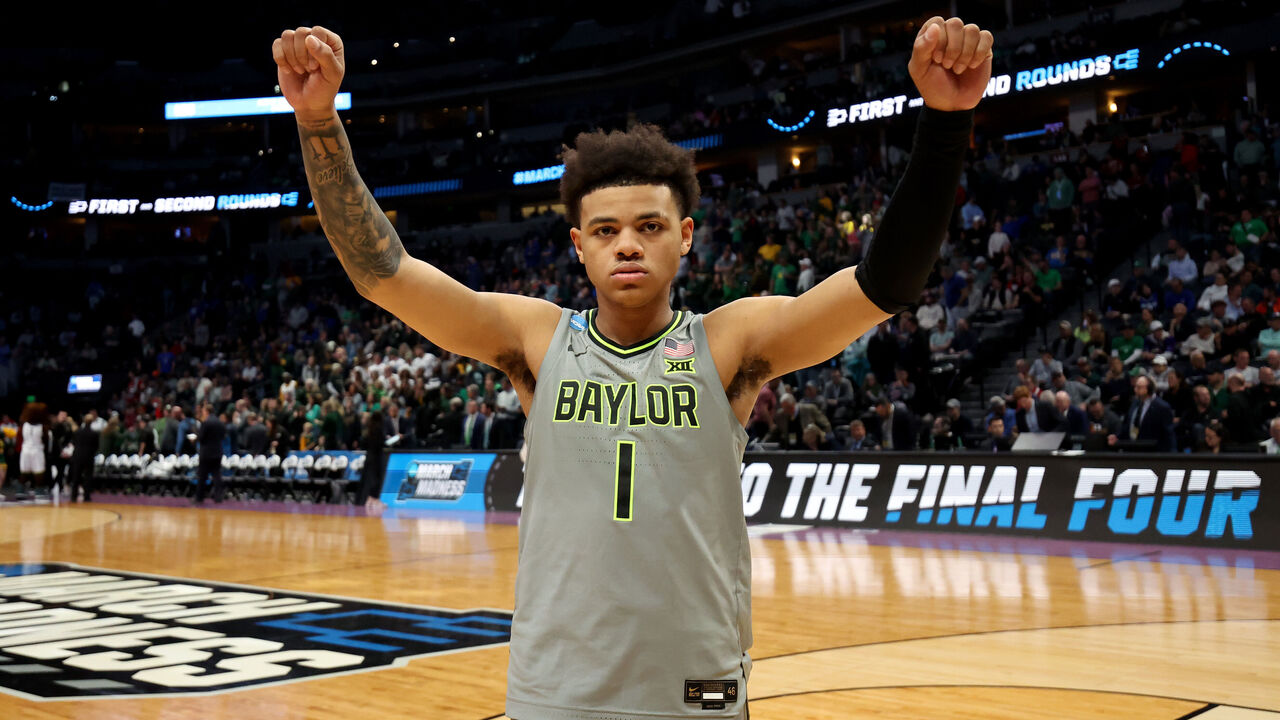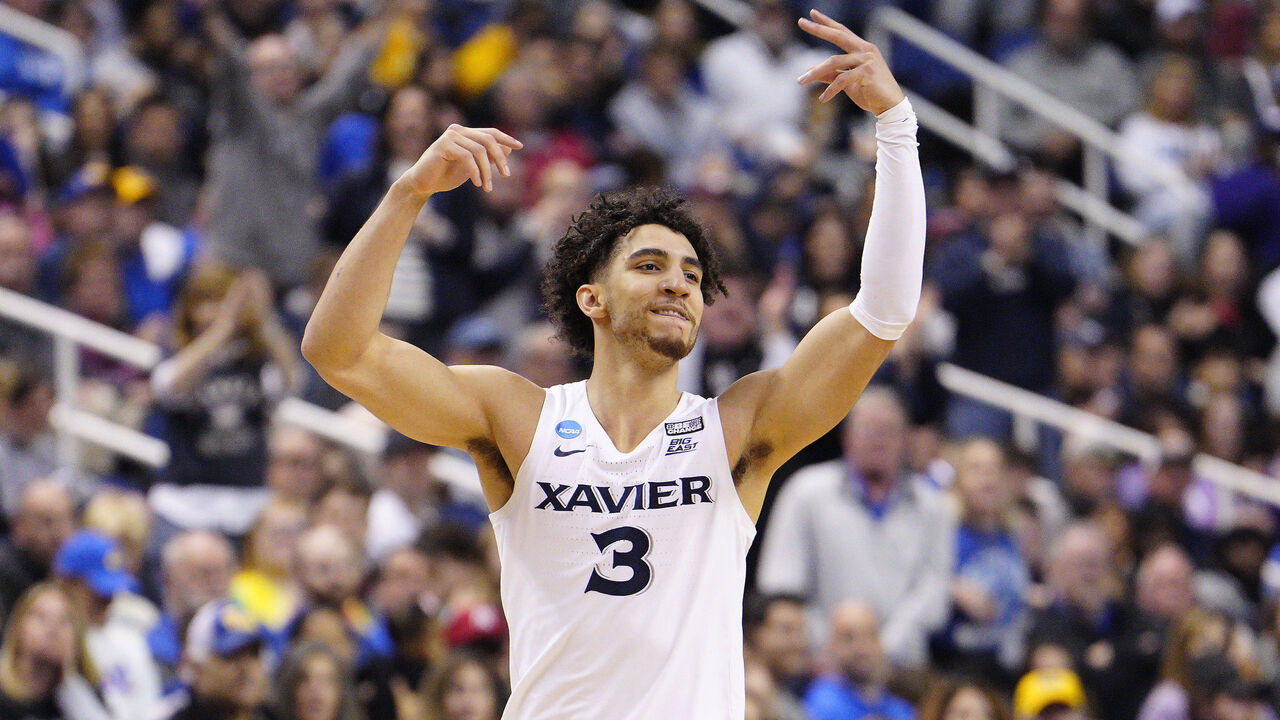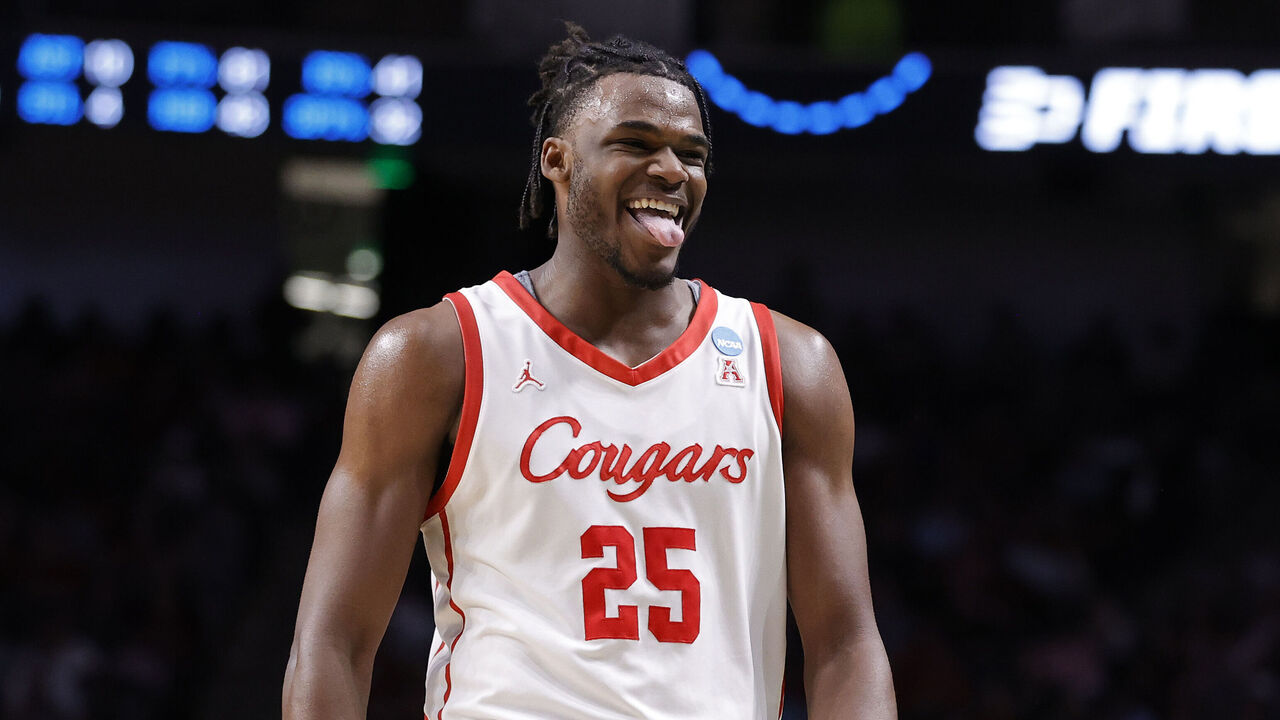2023 NBA Mock Draft: Final projections ahead of Thursday's event
The San Antonio Spurs are on the clock. Of the 30 picks set to take place during Thursday’s first round at the Barclays Center in Brooklyn, it appears to be the only one set in stone.
On the eve of the 2023 NBA Draft, it’s time to take one final gaze into the crystal ball and predict how the 21 teams with first-round picks might act when on the clock (draft order as of June 20.)
Victor Wembanyama, F, Metropolitans 92
The Spurs selecting Wembanyama at No. 1 has to be one of the easiest decisions in modern North American professional sports. The 7-foot-5 French phenom would immediately be the best player on the roster and a heavy favorite to lead the team in scoring.
Wembanyama is the type of player that teams build their roster around. He can defend the rim, score off the dribble, and initiate the offense. Wembanyama will also learn under one of the game’s greatest coaches in Gregg Popovich, who sports a big man development track record of Hall of Famers Tim Duncan and David Robinson. This pairing is not only a done deal, but also a match made in heaven.
Scoot Henderson, G, G League Ignite
This pick is very much in play ahead of draft night. In the event Charlotte keeps the selection, Henderson’s upside should supersede the concerns about his fit alongside LaMelo Ball.
Henderson would give the Hornets a dynamic backcourt tandem, with either player capable of pushing the pace in transition and facilitating the offense. His ability to attack downhill and pull up in the mid-range may result in cleaner 3-point looks for Ball. The Charlotte floor general made 40.4% of his catch-and-shoot triples last season, and the addition of Henderson could bolster that mark.
Read more: Scoot forged his own path to the NBA
Brandon Miller, F, Alabama
Though the Blazers would be missing out on their ideal target in Henderson at No. 2, Miller is still a terrific consolation prize for a team looking to complement Damian Lillard with competent wing options. That is, so long as Portland doesn’t trade this selection for a veteran instead.
A knockdown shooter with the length at 6-foot-9 to guard multiple positions, Miller’s versatility on both ends of the floor will see him make an impact from the very start of his NBA career, an important factor for a team hoping to win now. Plus, his ability to run the pick-and-pop makes the idea of a Miller-Lillard partnership a tantalizing thought for Blazers fans.
Amen Thompson, G, Overtime Elite
While the Rockets have accumulated some intriguing young talent, led by former top-five picks Jalen Green and Jabari Smith, they lack a true offensive initiator. Though there are some reports of a potential James Harden reunion, Houston could continue its youth movement by selecting a jumbo point guard in Thompson.
Standing at 6-foot-6 with a 7-foot wingspan, Thompson may be the best passer in the draft outside of Henderson. He also uses his top-tier athleticism to blow by defenders and menace in transition. A Thompson-Green backcourt would undeniably be the bounciest pairing in the entire league. That said, Thompson’s horrific shooting numbers and problematic form will be a giant question mark regarding his ceiling.
Jarace Walker, F, Houston

The Pistons have a bit of a frontcourt logjam. However, they won’t have any issues adding Walker, whose defensive skill set would fill a huge void in their lineup.
Walker would easily become the versatile stopper Detroit is missing, with his ability to not just defend opposing forwards but capably switch onto guards thanks to his agile footwork and 7-foot-3 wingspan. It’s not a stretch to say he’d instantly become the team’s best overall defender. That he can space the floor on occasion is only an added bonus.
Cam Whitmore, F, Villanova
The Magic are well-known for valuing positional size, and Whitmore’s powerful frame blends perfectly. A good fit on the wing next to rising forwards Franz Wagner and Paolo Banchero, Whitmore’s limitations as a playmaker would be covered by his teammates.
Shooting is Whitmore’s big swing skill. At Villanova, he shot over 40% from deep in 12 games and under 30% in the other 14. If the shooting evens out, his 3-and-D potential with plus-athleticism would work very well with Orlando’s growing core.
Ausar Thompson, F, Overtime Elite
Like his twin brother Amen, Thompson’s biggest drawback is his lack of shooting, but it’s also why the Pacers are a sublime landing spot.
With so many more-than-capable long-range shooters already in place, especially on the wing where Thompson’s expected to slot in long term, Indiana can rely on the explosive prospect to do what he’s already expected to do so well. He can shut down opposing point-of-attack threats while keeping his offensive game simple as a predominant lob threat with well-timed cuts.
Anthony Black, G, Arkansas
Washington might be eyeing a long-term floor general. Monte Morris and Delon Wright are both entering the final year of their contracts, and the Wizards’ point guards collectively finished 29th in points per game last season.
Black is a bigger guard with two-way potential. The Arkansas product consistently made high-level passing reads out of the pick-and-roll, and his ability to push the pace would inject some life into Washington’s transition offense. He also works extremely hard defensively, showing great instincts and versatility.
Taylor Hendricks, F, UCF
Hendricks falling right in the Jazz’s lap at No. 9 would be a huge win-win for both parties.
Thanks to his mix of defensive versatility, shot-blocking instincts, bouncy athleticism, and floor spacing, the 6-foot-8 UCF product is exactly the kind of piece Utah would love to complement breakout stars Lauri Markkanen and Walker Kessler with for the foreseeable future. The Jazz are also an ideal spot for the 19-year-old to flesh out his overarching offensive game in a low-pressure environment.
Dereck Lively, C, Duke

Luka Doncic was fifth in the NBA in pick-and-roll possessions last season but relied on 35-year-old JaVale McGee and undersized Dwight Powell as lob threats. The 7-foot-1 Lively would be the perfect center for the Mavericks due to his length and athleticism, even if his offensive production in college was more minimal than any other prospect in the draft.
Lively is also an immense defender who can protect the rim and switch onto smaller players, a must for a Dallas team that ranked 24th in defensive rating and 28th in blocks.
Gradey Dick, G, Kansas
Despite having Banchero on their roster, the Magic ranked just 26th in offensive efficiency last season. They specifically struggled from distance, finishing 24th and 25th, respectively, in 3-point percentage (34.6%) and triples per contest (10.8).
Few players in this year’s draft class shoot the ball better than Dick. The Kansas wing made over 40% of his threes and drilled the second-most triples (83) in the Big 12. He was an efficient catch-and-shoot threat, a weapon in dribble handoffs, and can pull up from beyond the arc in transition.
Bilal Coulibaly, G, Metropolitans 92
Just two months ago, Coulibaly wasn’t seen as a first-rounder. However, a strong close to his season in the French league alongside Wembanyama, while all the college prospects have been sitting dormant, has done the promising forward wonders.
Stocked with good size, great athletic ability, and a smooth jumper while being one of the youngest players in the draft sounds exactly like the type of prospect the Thunder have targeted in recent seasons. With young players at every position already, taking a gamble on a high-upside draftee makes sense.
Cason Wallace, G, Kentucky
With Fred VanVleet a candidate to jump ship this summer, the Raptors are likely to target a guard with their lottery pick. Wallace represents the best defender of the available options, and his 6-foot-9 wingspan fits Toronto’s frequent target of long-armed draft picks.
Wallace has room to grow offensively but has shown some promise as a playmaker and shooter. He may not possess All-Star potential, but at the very least, he’ll be a strong perimeter stopper with serviceable scoring.
Jordan Hawkins, G, UConn
New Orleans would benefit from more outside shooting around Zion Williamson and Brandon Ingram. Despite having Trey Murphy and CJ McCollum in the fold, the Pelicans still finished 23rd last season with 11 threes per contest.
Hawkins was a 42.8% 3-point shooter over two years at UConn and finished 12th in the NCAA this past campaign with 109 triples. His ability to shoot on the move could add another wrinkle to Willie Green’s offense.
Keyonte George, G, Baylor

Although the Hawks finished seventh in offensive efficiency last season, the club wasn’t lethal from beyond the arc. Atlanta made just under 10.8 triples per contest, tying the Magic and Los Angeles Lakers for 24th in the Association. George finished eighth in the ultra-competitive Big 12 with 77 threes during the 2022-23 campaign.
The Baylor product also provides insurance in the backcourt with Bogdan Bogdanovic’s injury history and Dejounte Murray’s expiring deal. George has the shot-creating and playmaking upside to develop into a lead guard at the next level. The 19-year-old’s potential should supersede his shooting inefficiencies at Waco this past season.
Nick Smith, G, Arkansas
A big combo guard with plenty of defensive promise and scoring capabilities, Smith and the Jazz could be a terrific pairing. The 6-foot-5 talent can enhance Utah as a backcourt option off the bench and provide instant offense while having the frame and agility to frequently disrupt opposing ball-handlers.
Depending on what the Jazz’s future plans are for Jordan Clarkson, Smith is an intriguing possibility to eventually replace him in the starting lineup. Smith will likely need much more time to refine his offensive game to match Clarkson’s output, but he’d already be a much better defender.
Kobe Bufkin, G, Michigan
Bufkin made a huge leap as a sophomore at Michigan, establishing himself as a dynamic combo guard that loves to attack the rim. He also finishes with remarkable efficiency for a guard, especially when he’s able to get downhill with his left hand.
With so few guards on their books for next season, Bufkin’s an optimal fit to come off the Lakers’ bench. There, he’ll be able to facilitate off screens as he did with the Wolverines or play in a more off-ball role thanks to his improvement as a shooter.
Rayan Rupert, F, New Zealand Breakers
As one of the NBA’s oldest teams, Rupert might be just what the Heat need. A defensive menace who played for the New Zealand Breakers of Australia’s National Basketball League last season, the French wing only turned 19 last month but looked more than comfortable during his team’s run to the NBL finals.
The 6-foot-6 Rupert is equipped with a massive 7-foot-2 wingspan, which he uses to frustrate opponents with his on-ball defense and by clogging passing lanes. His shot and finishing through contact still need some work, but he’d be an easy addition to a squad that boasted the league’s ninth-best regular-season defense in 2022-23.
Jett Howard, F, Michigan
Even the Warriors could always use more shooting. With the future of the team’s core very much in the air, Howard would still complement Golden State as one of the draft’s best pure shooters, especially as a catch-and-shoot threat. His 6-foot-8 frame and quick release make it a nightmare for opponents to close out.
Howard’s most significant shortcoming is arguably his occasional poor defensive effort. However, with skilled career defenders like Klay Thompson, Andrew Wiggins, Draymond Green, and Gary Payton II, Golden State is well-equipped to compensate for him on that end.
Dariq Whitehead, G, Duke

Houston’s priority should be stockpiling young talent. Whitehead, who entered the 2022-23 campaign as the No. 2 overall recruit on the ESPN 100, would be quite the coup at this stage of the draft. Despite undergoing two foot procedures, with the most recent one coming earlier this month, the former McDonald’s All-American shot 42.9% from deep and showed promising flashes defensively as a freshman.
Whitehead’s ceiling is certainly worth a roll of the dice, and his 3-point efficiency just happens to address one of the Rockets’ most glaring needs.
Jalen Hood-Schifino, G, Indiana
With back-to-back picks in the early 20s, the Nets would be well-served to fill out their retooled roster with role players who could provide value alongside burgeoning star Mikal Bridges. Hood-Schifino is far from a perfect prospect due to an inconsistent jumper and athleticism concerns, but he’s a maestro with the ball in his hands and never gets sped up on offense.
Brice Sensabaugh, F, Ohio State
There’s no denying that Sensabaugh is a gifted offensive player, but his unconventional build and lack of defense have raised questions about what he can provide to a winning team. Even though he kind of represents the forward version of someone like Cam Thomas, the Nets could use a little extra scoring punch in their frontcourt.
Kris Murray, F, Iowa
Should Portland continue building around Lillard, the team will need a plug-and-play rotational piece. Murray is among the more pro-ready prospects in this year’s class. His ability to shoot the three and defend multiple positions is highly coveted in today’s NBA. The Blazers have finished no higher than 27th in defensive efficiency over the last four campaigns.
Leonard Miller, F, G League Ignite
Miller tested the draft waters last year before ultimately joining the Ignite for the 2022-23 campaign. The decision appeared to pay off as he excelled against professional competition, averaging 18 points and 11 boards to go along with 17 double-doubles. Miller’s ball-handling skills, finishing at the rim, and athleticism are a tantalizing combination for a player of his size. The Kings lack depth in their frontcourt, and the 6-foot-10 forward is an intriguing long-term solution.
Colby Jones, F, Xavier

Dillon Brooks’ departure leaves the Grizzlies with a gaping hole at the wing. Jones is a candidate to fill some of those minutes from the get-go. The 21-year-old connected on 37.8% of his 3-point attempts last season and has the physical attributes to be a multi-positional defender. His secondary ball-handling skills and playmaking ability will be an asset as well, especially with Ja Morant suspended for the first 25 games of the upcoming campaign.
Brandin Podziemski, G, Santa Clara
Podziemski was historically productive in his only season at Santa Clara. He became the first player in modern college basketball history to average at least 19 points, eight rebounds, and 3.5 assists while making more than 43% of his 3-pointers.
He’ll likely be a defensive liability, but for a Pacers team that could use an injection of bench scoring, there’s no reason not to pull the trigger this late in the first round.
Olivier Maxence-Prosper, F, Marquette
Charlotte has finished in the bottom third for defensive efficiency four times over the past five seasons. Prosper’s ability to guard up and down the lineup should immediately help the Hornets.
The 6-foot-8 wing thrived in Marquette’s switching schemes and routinely took on the opposition’s top perimeter threat. He successfully defended different styles of players, including fellow first-round prospects Whitmore, Hawkins, and Jones.
Maxwell Lewis, F, Pepperdine
Lewis impressed at Pepperdine as a catch-and-shoot threat that’ll hurt opponents who give him even an inch of space. He’s also adept at using his long frame to cause headaches inside, where he’s comfortable backing defenders down or pulling up from mid-range.
Defensively, though, he’s still very raw and hasn’t produced consistent results on that end despite possessing the right physical tools and athleticism. A landing spot like Utah, which was able to hone Walker Kessler’s defensive instincts last season, would be a solid fit.
Noah Clowney, F, Alabama
Clowney’s lauded defensive potential could make him a highly underrated late first-round pickup where a team like the Pacers might stand most to benefit.
Standing 6-foot-10 with a lengthy 7-foot-2 wingspan, he showed off superb timing and instincts as a recovering shot-blocker but can also hold his own on the perimeter due to his great mobility. His shot is an unfinished product, and he’ll likely be undersized against opposing bigs to start. However, the Pacers offer him a great destination with plenty of time to develop and fill out his frame while studying under an elite shot-blocker like Myles Turner.
Ben Sheppard, G, Belmont
Sheppard was a late riser in the draft process thanks to a strong performance at the combine after going relatively unnoticed for four years at mid-major Belmont. His blend of shooting, defense, and size at the guard position makes him a solid yet unspectacular selection that could be a habitual rotation piece as a rookie for a Clippers team that’s fighting the salary cap.


